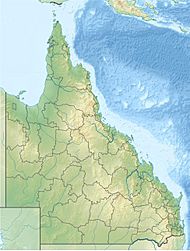Hoskyn Islands facts for kids
Quick facts for kids Hoskyn IslandsQueensland |
|
|---|---|
| Nearest town or city | Gladstone |
| Area | 1.65 ha (4.08 acres) |
| Managing authorities | Queensland Parks and Wildlife Service |
| Website | Hoskyn Islands |
The Hoskyn Islands are two small islands made of coral. They are called cays. These islands are found in the southern part of the Great Barrier Reef in Queensland, Australia. They are about 107 kilometers (66 miles) east of Gladstone.
The Hoskyn Islands are part of a group of islands called the Capricorn and Bunker Group. They are also part of the Capricornia Cays National Park. This park is a special place that protects many birds. Many people visit nearby Lady Musgrave Island, which is easier to reach by boat from towns like 1770 or Gladstone.
The two Hoskyn cays are:
- East Hoskyn 23°48′26″S 152°17′27″E / 23.80722°S 152.29083°E
- West Hoskyn 23°48′06″S 152°18′00″E / 23.80167°S 152.30000°E
Contents
How the Hoskyn Islands Formed
The eastern island is made of small, broken pieces of coral and shells, called shingle. It has plants, but they are not as developed as those on Lady Musgrave Island. The western island is made of sand and has plants similar to other sandy islands in the Capricorn Group. Both islands have grown bigger since 1936.
The islands and their reefs are part of a special area at the southern end of the Great Barrier Reef. They sit on a shelf of land under the sea, separated from the mainland by a channel. You usually can't see these islands from the mainland.
These islands are quite young in terms of geology. They formed during the Holocene period, which began about 10,000 years ago. Most of them are around 5,000 years old. Before that, during the last Ice Age, the sea level was much lower. The area where the reefs and islands are now was dry land.
About 10,000 years ago, the sea level started to rise. It settled at its current level around 6,000 years ago. Once the sea stopped rising, flat areas of reef could grow. These flat areas then became places where islands could form.
Hoskyn Reefs are shaped like a closed ring. The size and what the islands are made of (sand, shingle, or both) depend on the size of the reef and how much wind and waves hit them. Strong storms like cyclones can change the islands a lot.
The coral islands here are of two main types:
- Sandy islands with plants: Hoskyn (West)
- Shingle islands: Hoskyn (East)
The sandy island is found on the calmer side of its reef. The shingle island is on the side that faces the wind.
History of the Islands
Early Discoveries
In 1803, Captain Eber Bunker was the first European to find this area. He was on a whaling ship called Albion. The southern group of islands is named after him.
Later, between 1819 and 1821, Lieutenant Phillip Parker King of the Royal Navy mapped these islands. The main mapping of all the islands and reefs happened in 1843. This was done by Captain Francis Price Blackwood on the ship HMS Fly. A naturalist named Professor Joseph Jukes was on board and wrote important notes about some of the islands.
Guano Mining in the 1930s
Guano is the droppings of seabirds. It was used as a natural fertilizer. People mined guano on other nearby islands like Lady Musgrave Island and North West Island in the 1890s.
In September 1933, the rights to mine guano on Fairfax and Hoskyn Islands were sold. A company called Barrier Reef Phosphate (Guano) Syndicate bought them. It's not clear if they actually removed much guano from Hoskyn Islands. However, the company planned to take a lot of the bird droppings to use as fertilizer.
A newspaper article from that time said: "The Barrier Reef Phosphate (Guano) Syndicate's interests have been taken over by Phosphates Pty, Ltd. This new company plans to work guano deposits. A survey showed there are 20,000 tons of guano ready to be used. Tests showed it has nitrogen and phosphoric acid, making it good for fertilizer. The company also planned to use coral from the islands to make lime. They also wanted to prepare turtle soup and other products for sale overseas."
Wildlife and Nature
The Hoskyn Islands are important for wildlife. Green turtles lay their eggs on West Hoskyn Island. These areas are kept natural and free from human disturbance to protect the turtles.
A small bird called the Capricorn silvereye lives only in the southern Great Barrier Reef, and it can be found on these islands. There are also brown booby birds that breed on East Hoskyn Island, as well as on East and West Fairfax Islands.
The plants on the Hoskyn Islands include trees like Pisonia, Ficus (fig trees), and Pandanus (screw pines).


